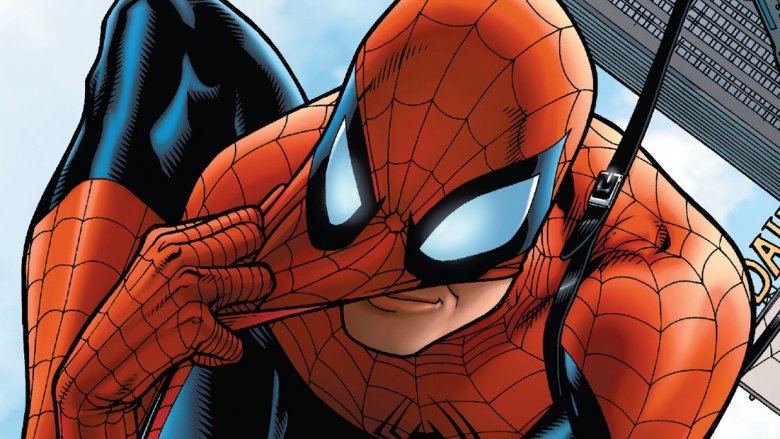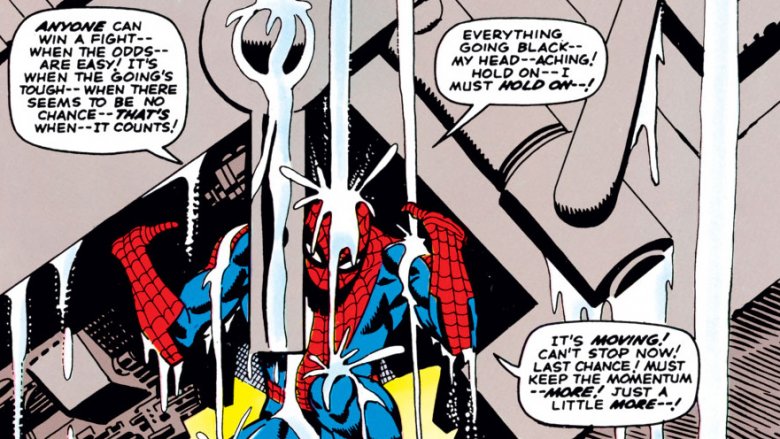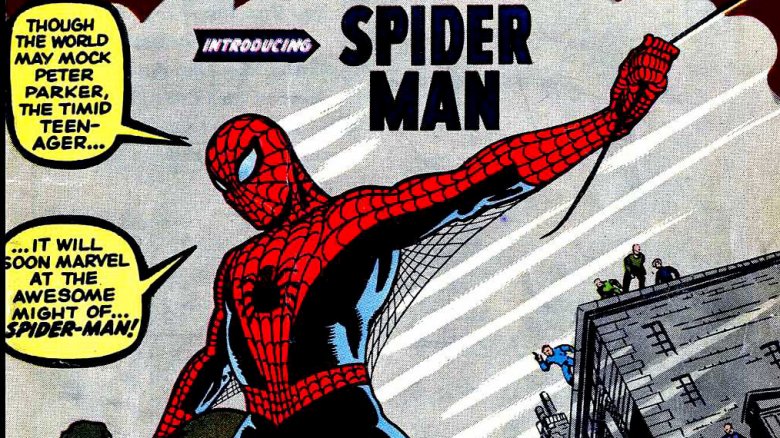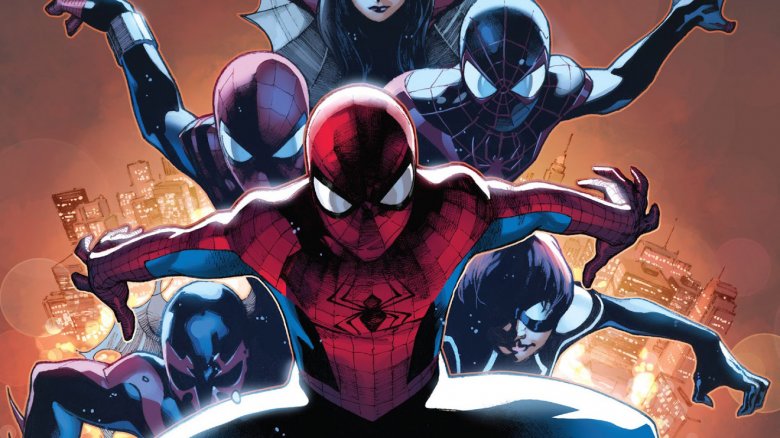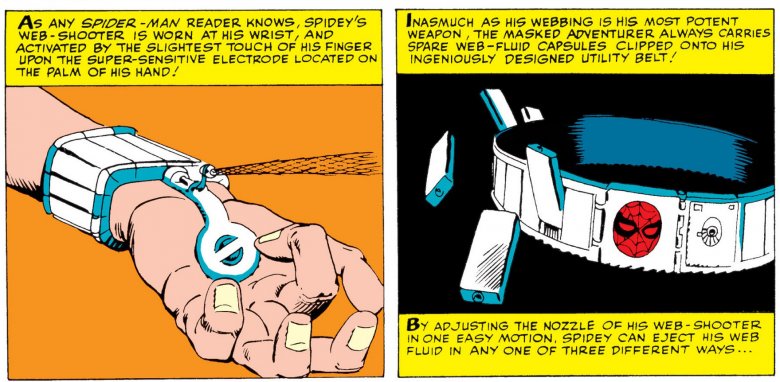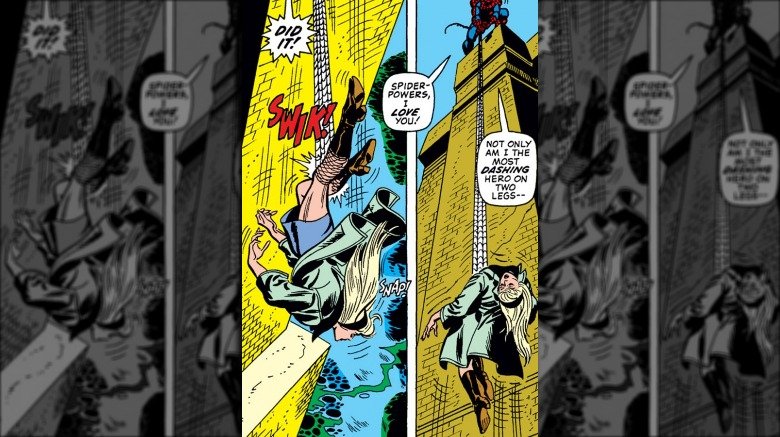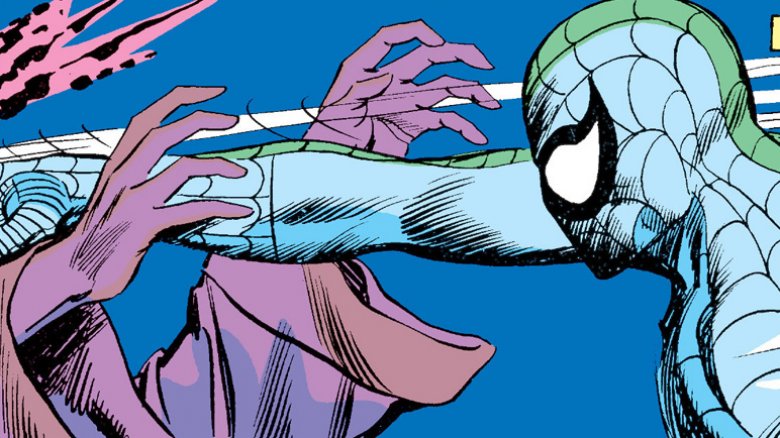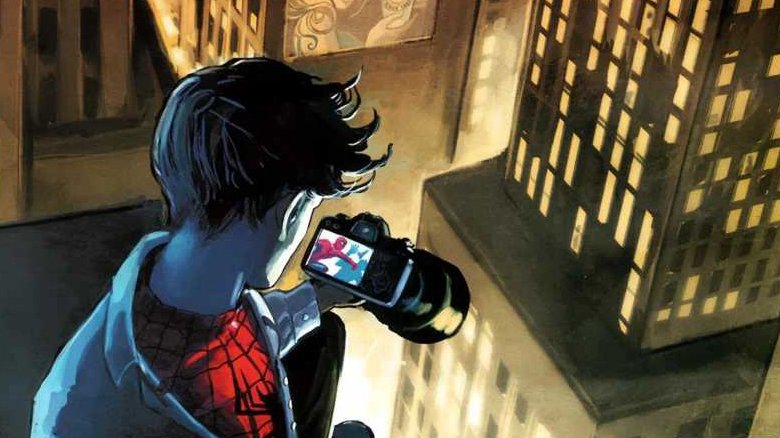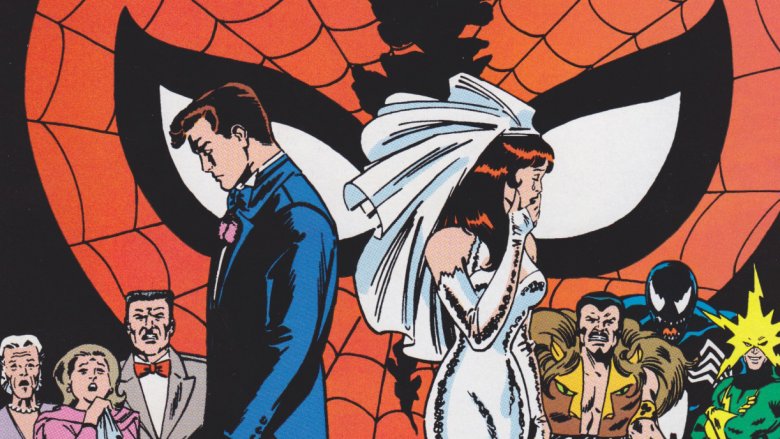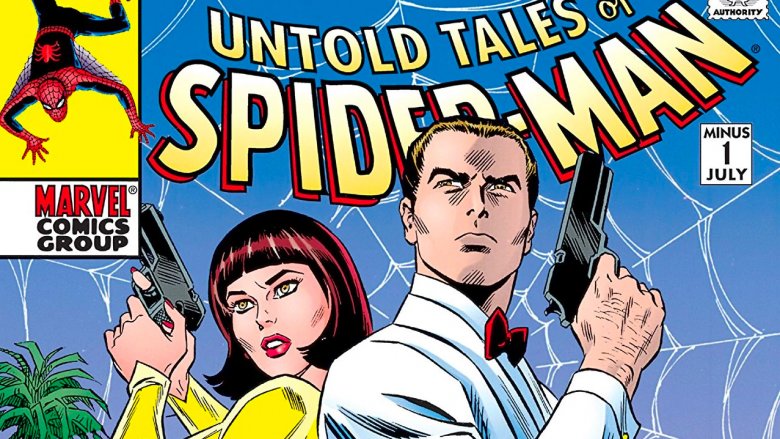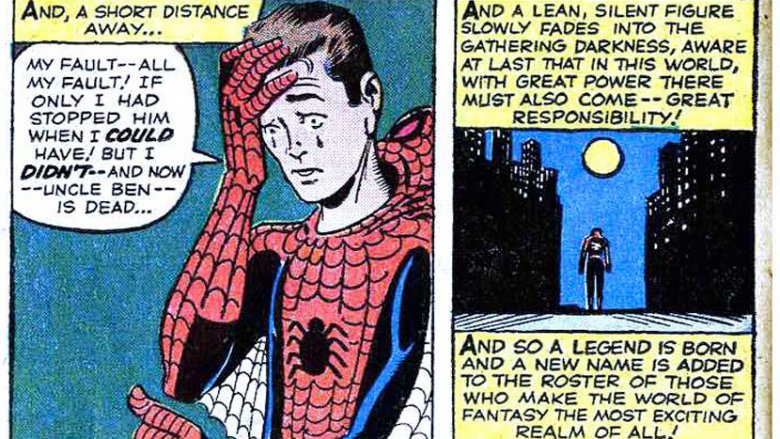False Facts About Spider-Man You Thought Were True
Since his debut in 1962, Spider-Man has been one of the most popular superheroes in the world, and with appearances in countless comics, cartoons, three different film franchises, and even a live-action Japanese television show that would help to define the Power Rangers (really!), he's also one of the most well known. As easy as it might be to think you know everything about Marvel's flagship web-slinger, though, there are plenty of misconceptions about Peter Parker's amazing, spectacular, and sensational alter-ego.
Can Spider-Man really do whatever a spider can? Does he really have radioactive blood? Has he really ignored wealth and fame in favor of choosing action as his only reward? All these questions and more have been examined on the comics page, but if you need to brush up on the truth behind Spider-Man, read on to find out the real answers behind some false "facts" about Spidey that you might have been believing all along.
Stan Lee's most enduring classics?
Of all the original Marvel Universe titles, The Amazing Spider-Man is the one most strongly identified with Stan "The Man" Lee. While he was one of the creators who helped to launch all the company's earliest hits, including the Avengers, the X-Men, the Hulk, and more, Spidey was the character he stuck with the longest, scripting the first 100 issues and then staying on sporadically until finally passing it to Gerry Conway at #118, a tenure that's even longer than the 108 straight issues of Fantastic Four he did with legendary artist Jack Kirby.
If, however, you think Stan's the only one responsible for the thrills of those early adventures, you're mistaken. Most fans are aware that Lee pioneered the "Marvel Style" of writing, in which he'd collaborate with an artist on a loose plot, then add in the dialogue after everything else was done. What's a little less well-known, however, is that his relationship with artist and Spidey co-creator Steve Ditko was one of the first to deteriorate. According to Sean Howe's Marvel Comics: The Untold Story, the latter chunk of Ditko's 38-issue run — including the legendary "Final Chapter," in #33 which gave the world the iconic image of Spider-Man fighting his way out from under a massive heap of fallen machinery — was produced without Ditko and Lee speaking to each other at all.
Of course, that doesn't mean Lee wasn't a necessary ingredient for Spider-Man's early success. Lee's soaring dialogue made those issues work, and the fact that he stayed with the character for almost seven years after Ditko's departure through some of what are still considered the best years of Spider-Man is a testament to how important he was to the character — and how well he got along with Ditko's replacement, John Romita.
The hoax of the 'original Jack Kirby design'
One well-known piece of comics trivia is that Steve Ditko was not Stan Lee's first choice for the job of co-creating Spider-Man. Instead, following the success they'd had with the Fantastic Four, Lee turned to his long-time collaborator, Jack Kirby. At the time, Spider-Man was a very different character, and while Kirby did some early concept work, Lee would say in an interview in 2002 that he "hated" those designs. Ditko got the job and wound up completely redesigning the character's famous red-and-blue outfit. Kirby's contribution to the early days of Spider-Man was limited to being the cover artist (under Ditko's inks) of his first appearance in Amazing Fantasy #15.
If you think you've seen Kirby's designs, however, you've either encountered a legitimately lost piece of comics history or you've been taken in by a hoax. In 2012, a design for "Jack Kirby's Spiderman" began floating around. It was an interesting look at what a Kirby Spidey might've been, but it turned out to be a fake. Rather than an original, it was a copy of a shot of Giant Man from the pages of Tales to Astonish, with some elements that Lee and Ditko had discussed in interviews added in and a couple of spidery touches thrown in for good measure.
While it's an interesting exercise in trying to figure out what those early concepts might've looked like — and a pretty cool attempt at working backward from Ditko's iconic costume to Kirby's signature style — it's definitely not legit.
The Spectacularly Singular Peter Parker?
The one thing about Spider-Man that's always been true is that underneath that mask, it's always Peter Parker. It's what makes him so easy to relate to, that beneath the proportionate strength and speed of a spider, he's just an average everyday scientific super-genius with problems just like ours, like juggling our long-term relationships to supermodels while making a living off selfies. That's why Spider-Man always has to be Peter ... except for all those times it's someone else.
While Peter Parker has certainly been the primary identity for Spider-Man since his debut in 1962, he's definitely not the only one. For a while in the '90s, Spider-Man was instead Ben Reilly, a clone of Peter (made by a villain called the Jackal) who was tricked into thinking he was the genuine article right around the time Peter lost his powers. He dyed his hair blonde, got a job at a coffee shop, and took over the role with a new costume for the entirety of 1996 before eventually dissolving into a pile of dust. Like most comic book deaths, that one proved to be temporary, although Ben hasn't been Spider-Man since.
More recently, Peter found his own consciousness overwritten by Doctor Octopus, who took over his life as the Superior Spider-Man. Beyond just variations on Peter Parker's body — and enough alternate universe versions that they have their own special team — there's an entirely different Spider-Man in the Marvel Universe: Miles Morales, a native of the "Ultimate" line of comics who migrated to the core Marvel Earth after Secret Wars. And that's not even getting into Miguel O'Hara, who's going to show up in about 80 years as the Spider-Man of 2099.
Organic web-shooters?
If you were the type of person to hang around in comic book stores back in 2002 when the first Spider-Man movie came out, you might remember that one of the most intense (and unlikely) arguments back then concerned whether Spider-Man's web-shooters were mechanical or an organic byproduct of his spider-powers. The thing is, if that's still a hill you're willing to web-sling up to die on, you're wrong either way.
When Sam Raimi's film hit theaters, one of the few notable changes that it made to Spider-Man's origin story — along with the inclusion of "The Macho Man" Randy Savage — came with the addition of organic web-shooters. This proved to be so controversial that when the next movies were announced in 2010, the decision to use the mechanical web-shooters literally made headlines. It makes a certain kind of sense, too, with die-hard purists claiming that the web-shooters were a testament to Peter Parker's genius, a necessary element of his character. Besides, he never had organic web-shooters in the comics.
Or at least, he didn't have them in the comics before the movies. After their success, a 2005 storyline called "The Other" ended with Peter getting organic webs (and a weird set of claws called "stingers"). Those didn't last either — they inexplicably disappeared with the back-to-basics approach of the "Brand New Day" story two years later — but other Marvel Universe spider-characters retained them. In fact, Cindy Moon, a classmate of Peter's who was bitten by the same radioactive spider, is so capable of spinning her own webs that her superheroic codename became "Silk."
Who killed Gwen Stacy?
One of the defining tragedies of Spider-Man's life was the death of Gwen Stacy. In the '60s, she was the love of Peter Parker's life, forming a complicated love rectangle with Mary Jane Watson and Harry Osborn and providing the backbone of the soap opera that underscored his Spidey superheroics. In Amazing Spider-Man #121, the Green Goblin kidnapped her and used her as bait to lure Spider-Man into a battle at the top of the George Washington Bridge, and while the story title wasn't revealed until the last page, "The Night Gwen Stacy Died" lived up to its name.
The Goblin is definitely to blame for Gwen's murder — he's the one who took her to the top of the bridge and the one who threw her off, all in an effort to torture Spider-Man. If, however, you really want to get technical about things, he's not the one responsible for what literally killed her. That sad honor goes to Spider-Man himself.
It's easy to miss, but the real tragedy can be seen in a tiny sound effect next to Gwen's head. When Spider-Man tried to save Gwen by snagging her leg with a web line as she plunged toward the Hudson River, the sudden stop proved to be the fatal moment. A small "snap!" next to Gwen's neck shows it was a broken neck from Peter's attempt at saving her that actually ended Gwen's life.
Nobody dies?
Spider-Man doesn't kill. It's one of the absolute, inviolable rules of the character, and it's been the centerpiece of plenty of stories, from simple explanations of how he always pulls his punches when he's fighting normal crooks to stories where he has to struggle to find a way to defeat ruthless villains without killing them. Unlike other heroes, he's lived up to it, too — in over 50 years of comics, Spider-Man has never actually killed anyone himself. Except for the one time he did.
It happened in the pages of Spider-Man vs. Wolverine, a 1987 one-shot by Christopher Priest and Mark Bright that pulled Spidey into a dark world of international espionage. The conflict between the two title characters is largely built around a spy codenamed Charlemagne who is described as Wolverine's best friend from his days as a government operative. In this story, Charlie wants Wolverine to kill her so she won't be apprehended and spend the rest of her life being tortured in a gulag.
When Spider-Man stumbles into this situation, all he knows is Wolverine is trying to kill a woman. In the fight that ensues, Spidey takes advantage of Wolverine's adamantium skeleton and healing factor and unleashes his full strength on the X-Man, "hitting him with blows that would wreck cars." Sadly, Charlie takes advantage of the brutal conflict, tricking Spider-Man into hitting her with his full strength, using him to commit suicide. Peter was understandably traumatized by the event, and while he and Wolverine have made peace in the years since, it was a source of bitter enmity between them for a long time.
The Daily Bugle's freelance photographer
The iconic image of Peter Parker is of a young man struggling to make ends meet by working as a freelance photographer, selling snapshots of his own superheroic exploits to the Daily Bugle to satisfy J. Jonah Jameson's demand for pictures of Spider-Man. If that's your only concept of what Spidey does when he's not out fighting crime, however, it's time for an update. The truth is, while Peter worked for the Bugle for decades in a lot of classic stories, he hasn't actually been a freelance photographer for most of this century.
Starting in 2001, Pete returned to his old stomping grounds of Midtown High as a science teacher, but that proved to be a pretty short-lived career choice. In the years since, he's taken a job for Tony Stark, both officially as technician and off the books as a member of the Avengers. After that, he worked for a think tank called Horizon Labs where he reverse-engineered his crime-fighting gadgets into consumer goods, like making noise-canceling headphones out of a special costume meant to fight a villain with a mastery of sonic attacks. He even founded his own multinational corporation called Parker Industries — although technically, it was Otto Octavius who founded that company while he was in Peter's body, and Peter had to destroy it to keep it from being taken over by Nazis. Comics are complicated.
Most recently, Pete's returned to the Bugle, but this time, it was as an editor for the science supplement rather than a photographer. That wasn't the only change to the paper's staff, either: After being forced out due to a hostile takeover, J. Jonah Jameson himself was elected mayor of New York City and then took a job as a TV news pundit on the Fact Channel.
Til death (or devil) do they part
One of the more controversial moments in Spider-Man's comics history involved a literal deal with the devil. After Peter revealed his identity during the events of Civil War, his family was targeted by bad guys who nearly killed Aunt May, which was a good reminder of why he had the whole secret identity thing to begin with. Unfortunately for the Parker family, that sort of reveal isn't the kind of thing you can undo ... unless you're willing to make an infernal bargain with Mephisto.
Which is exactly what happened in a storyline called "One More Day." Rather than selling their souls, however, Peter and then-wife Mary Jane Watson sold their marriage, effectively erasing their nuptials from Marvel Comics continuity as though it had never happened. In the Spider-Man comics, Peter and MJ were both freed up to pursue new relationships, but don't let that fool you into thinking the marriage is completely gone.
In order to go along with the comic book storyline, the Spider-Man newspaper strip did away with the marriage as well. Readers reacted so poorly, however, that in the strip that ran on May 24, 2009, the elimination of the marriage was revealed to have been a dream. Ever since, Newspaper Spidey has remained happily married ... or at least as happy as anyone can be when they spend most of their time getting knocked unconscious right next to the Junior Jumble.
The spectacular Spider-Parents
Everyone knows that Peter Parker was orphaned at a young age and raised by Aunt May and Uncle Ben. Considering that he's meant to be one of the Marvel Universe's most relatable characters, and that his surrogate parents were about as wholesome and salt-of-the-earth as people could be, it stands to reason that Richard and Mary Parker were cut from the same cloth, right?
Wrong. In 1968, it was revealed that when the Parker Parents died, they were under a cloud of suspicion as traitors to their country. The truth, however, was that they were spies working for S.H.I.E.L.D. who had infiltrated the Red Skull's criminal organization before being killed, without ever getting the chance to clear their names. Yes: In case you missed that, Spider-Man's parents were spies who were murdered by Captain America's arch-nemesis. If that's not weird enough, they later turned up alive, only to be revealed even later to be robot duplicates.
That's not the end of the Parker family's secrets, though. It turns out that in addition to the parents he never knew, Spidey also had a long-lost older sister, Teresa, who was herself a S.H.I.E.L.D. agent. After a team-up in which it was revealed that her memories of the Parkers were falsely implanted by Mephisto (this dude again), it turned out that was also a ruse. She was, in fact, Peter's actual sister, and even pitched in to help him fight bad guys using her spy skills.
With great power comes great dialogue
If you've ever read virtually any Spider-Man comic — or seen him in a movie, or a cartoon, or encountered the character pretty much anywhere — then you've almost certainly seen the motto that guides his life: "with great power comes great responsibility." As we all know, this was the definitive lesson that Uncle Ben taught his nephew before he died ... except Ben Parker never actually said those words.
In Amazing Fantasy #15, Spidey's often-referenced motto is never spoken out loud by any character, let alone Uncle Ben. Instead, it only appears in a caption at the end of the story as a moral lesson imparted by ... well, Stan Lee. Spidey himself doesn't even say it out loud until 25 years later, in 1987. As time went on, though, the phrase became more and more identified with Ben, largely because it would be really weird for Spider-Man to solemnly vow to accept the lesson that was imparted to him through narration by the guy who wrote his comics.
